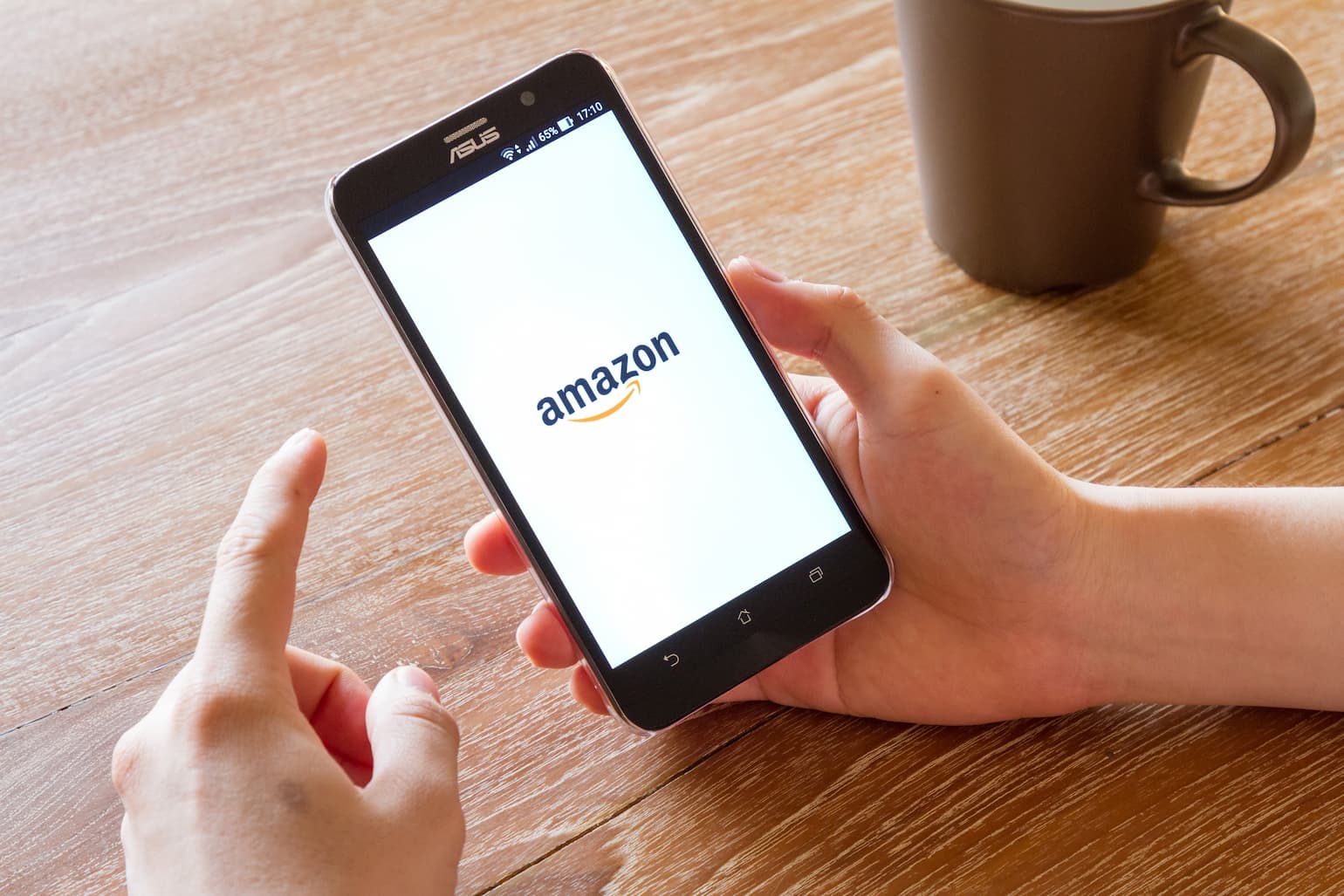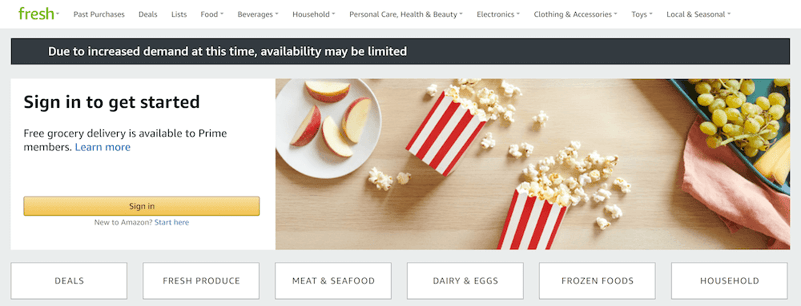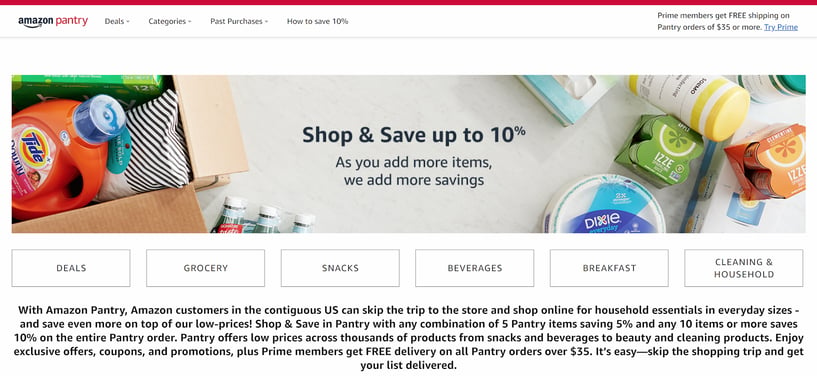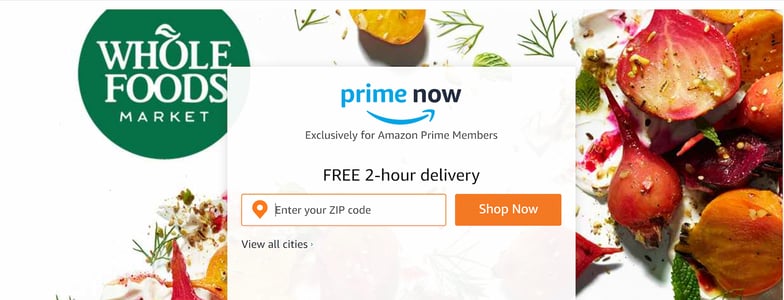

Author's Note: In January of 2021, Amazon announced the plan to phase out Prime Pantry in the US and fold those products into the main site.
In 2019, Amazon generated over $280 billion in revenue worldwide and contributed an estimation of nearly 43% of eCommerce sales in the U.S.. And as its growth shows no signs of slowing down, it is no secret that the company knows how to cater to the online consumer and adapt to their evolving needs. Part of this approach is introducing new services and shopping platforms that address specific online shopping gaps, such as receiving groceries without leaving the house and grouping smaller household items into one shipment to avoid high delivery fees.
Three of these services, Amazon Fresh, Prime Pantry and Prime Now, are popular among today’s tech-savvy shoppers. But what are their differences? Why are these services operating under three different channels? And where should brands focus their attention? We set out to clear the air a bit on this topic.
Contents:
- What is Amazon Fresh?
- What is Prime Pantry?
- What is Prime Now?
- What is the difference between Amazon Fresh, Prime Pantry and Prime Now?
- What do these services mean for brands?
- Where should brands offer their products?
- How can brands win on these platforms?
What is Amazon Fresh?
Amazon Fresh is Amazon’s online grocery delivery service that allows consumers to order perishable items and everyday essentials on-demand. Similar to a digital grocery store, this service offers products such as fresh produce, deli selections and supermarket basics.
Originating as a next-day delivery option, Amazon Fresh has expanded its fulfillment methods. When checking out, shoppers can now choose between:
- Attended delivery – This is the most traditional form of grocery delivery. Shoppers choose a specific time slot, usually a two-hour timeframe, that they will be home to retrieve their order and an Amazon Fresh delivery driver will complete the transaction in person.
- Doorstep delivery – If the shopper will not be home to receive their items, an Amazon Fresh delivery driver can leave the order waiting at the front door. Orders will be delivered in temperature-regulating bags, so there is no need to worry about food spoiling.
- Pickup – Only available in some cities, this option is free of charge and has no order minimum. Orders are reserved and retrieved from a pickup location, typically a Whole Foods store, and can be available in as little as 30 minutes.
The benefit of Amazon Fresh is that shoppers are able to purchase their favorite Whole Foods or other local grocery items at competitive prices, with delivery straight to their door.

What is Prime Pantry?
Prime Pantry is an Amazon delivery service that offers personal and bulk-sized pantry staples, and groups all items together in one shipment. This service specializes in products that come in everyday package sizes, such as a box of cereal or a can of soup, and larger, bulk items that are not practical to pick up from the store. Common items found on Prime Pantry include snacks, canned and bottled beverages, cleaning supplies, personal care and hygiene products, household goods and healthcare necessities.
A key feature of Prime Pantry is the Shop & Save option. In addition to traditional coupons and promotions, all available items automatically qualify for a 5-10% discount. A 5% discount is applied to any combination of five Pantry items; while any ten items or more gets you an automatic 10% off. However, when shopping on Prime Pantry, all items need to be marked with the black and blue “Prime Pantry” badge in order to be eligible for the service and count towards the $35 minimum.
The primary advantage of Prime Pantry for consumers is being able to receive their favorite individually sized items at a competitive price, which otherwise would not be eligible for free shipping on their own.

What is Prime Now?
Prime Now is Amazon’s online convenience delivery service that brings items to consumers directly from retail shelves. The products available on Prime Now are the least limited by category, ranging from food items to electronics to pet supplies to alcohol. However, specific product assortment is determined by location only after the user enters their zip code.
Depending on the location, Prime Now also offers the ability to shop from participating local stores and restaurants online. Similar to a service like Uber Eats or Postmates, shoppers can track the progress of their order online and receive delivery text notifications.
The allure of Prime Now for consumers is its near-instant gratification. Shoppers can receive their items quickly and in-person for any last-minute needs or impulse desires, such as baby diapers, phone chargers, party supplies or snacks.

What is the difference between Amazon Fresh, Prime Pantry and Prime Now?
With such similar names and offerings, it can be difficult to distinguish between the three services. Here is a quick cheat sheet that outlines their unique features.
|
Amazon Fresh |
Prime Pantry |
Prime Now |
|
|
Membership Cost |
Free with an Amazon Prime Membership, $119 per year |
Free with an Amazon Prime Membership; or an individual Prime Pantry membership can be purchased for $4.99/month, which lowers the minimum order value from $35 to $10 |
Free with an Amazon Prime Membership |
|
Fees |
Minimum order value ranges between $35-$50 per city; orders less than that are charged a $9.99 delivery fee |
Orders less than $35 are charged a flat $5.99 shipping fee |
Orders less than $35 are charged a flat $4.99 delivery fee; tipping is optional but recommended |
|
# of Products |
~500,000 total |
~2,000 total |
~10,000 per market |
|
Types of Products |
Groceries and essentials |
Non-perishable household goods |
Common convenience items and impulse buys |
|
Fulfillment Location |
Amazon fulfillment centers |
Amazon fulfillment centers |
Whole Foods and local stores |
|
Delivery Type |
Local Amazon Fresh delivery trucks |
Conventional ground shipping (USPS, UPS, Fedex, etc.) |
Contracted Prime Now delivery drivers |
|
Delivery Speed |
Can choose a specific delivery time window or receive in an average of 2-3 hours |
Average of 1-4 days |
Average of 2-3 hours with 1-hour delivery sometimes available for an additional fee |
|
Availability |
Offered in 2,000+ cities across the U.S. and a few major global cities |
Only available in the continental U.S. |
Available in 75+ major U.S. cities and more than 15 other cities worldwide |
|
Competitors |
Online grocery delivery providers, such as Instacart or Shipt |
Household items subscription services, such as Target Restock |
Last-minute needs delivery services, such as goPuff or Postmates |
|
Website |
It is important to note that due to the elimination of the separate Amazon Fresh membership fee, which used to be $14.99 per month, Amazon Fresh and Prime Now function very similarly. There has been speculation that the two services could merge under one platform in the future, but for now, they remain under separate umbrellas.
What do these services mean for brands?
Amazon is known as an innovator in the world of eCommerce and is one of the very few online businesses that have sustained a high rate of growth, 20.5% from 2018 to 2019, to be exact. This achievement places the company in a position to try out new platforms and fulfillment methods to expand their reach even further. Just in 2019 alone, after dropping membership fees, Amazon Fresh experienced a 30% increase in customer adoption. In addition, Amazon now has more than 150 million Prime members and, on average, around 25% of Prime members have also taken advantage of Prime Pantry and Prime Now services.
The rise in popularity of these services means that consumers are looking for more options when it comes to online shopping. With more options means more considerations, and consumers are tending to prefer convenience, flexibility and customization above all else. This is where services like Amazon Fresh, Prime Pantry and Prime Now come into play.
Therefore, it is important that brands get ahead of the curve and leverage these platforms when selling their products. And since these services are relatively new, brands can still reap the benefits of the “flywheel effect.” That is, brands that move early, and invest concentrated effort in their strategy over time, will experience outsized performance that builds momentum without having to increase work. Algorithms for retailers like Amazon tend to favor products that execute well early on in search rankings and traffic.
Where should brands offer their products?
All three of these services present a unique opportunity for brands to reach new audiences and take advantage of Amazon’s widespread success. But which platform is best for your products?
Amazon Fresh
With a rise in online grocery pickup and services that offer same-day grocery delivery, Amazon Fresh is the eCommerce giant’s way of playing in that space. Therefore, the brands that might receive the most return from being on the Amazon Fresh platform are mostly grocery, gourmet, or food and beverage based.
Amazon Fresh chooses its suppliers directly from existing Amazon 1P sellers and Whole Foods suppliers. Brands cannot directly apply to be included in the service, they must be invited by Amazon. While there are no known requirements for being invited, brands building forward momentum in sales and success on Amazon doesn’t hurt.
Prime Pantry
Prime Pantry is ideal for brands that specialize in bulk and individual-sized items, as its service model revolves around creating a full basket of products to meet minimum order requirements. Additionally, Prime Pantry is well suited for items that are reordered often, such as toilet paper, as they give shoppers the option to simply reorder the same products rather than refill their cart time and time again. Types of brands that should consider selling with Prime Pantry include consumer packaged goods (CPG), personal and health care, beauty supplies and household goods.
Selling on Prime Pantry currently is only available for grocery and CPG brands that are existing Amazon vendors. This is because Amazon relies on the 1P method to operate and fulfill orders, packaging the items together in-house. Using this model also helps guarantee products are available and in-stock for purchase.
Brands that use Amazon Vendor Central and wish to be included on Prime Pantry must:
- Ensure their items meet Prime Pantry requirements, such as weight restrictions (under 45 lbs.) and not being perishable.
- Boost sales velocity for eligible items to prove their brand will succeed by being offered through the service.
- Submit a request to an Amazon Vendor Manager to be included in the program and receive a “Prime Pantry” badge on the product description page.
Prime Now
Prime Now is a platform for items that succeed with quicker delivery times than traditional methods can offer. Therefore, through the separate app or website, Amazon tries to offer products that fulfill immediate needs, such as replenishing household items (think diapers), fulfilling an impulsive urge to buy something (think ice cream), or catering to last-minute situations (think party supplies). While Prime Now can be suitable for most brands, it has proven success with the alcohol, electronics, and sweets and snacks sectors.
Getting products on Prime Now is entirely reliant on local availability. Instead of pulling orders from Amazon fulfillment centers, this service retrieves items directly from store shelves. Therefore, the key to being available on Prime Now is having product available in participating stores, such as Whole Foods and local grocery chains.
How can brands win on these platforms?
Once you have determined which service is a good fit for your products, it is crucial to optimize your eCommerce strategy in order to win on these platforms. A few recommendations for brands on Amazon’s specialized programs include:
- Strategically choose your assortment.
Compared to the millions of products listed on Amazon, Amazon Fresh, Prime Pantry and Prime Now offer a much smaller selection. Due to this, the company limits the product assortment on each of these platforms to maximize fulfillment efficiency. Therefore, you must be strategic when deciding which products to showcase. Choose items that have higher conversion rates, best seller ranks, and positive ratings and reviews. Even further, take into consideration products that may be viable in smaller pack configurations, since this is a niche these platforms aim to fill in contrast to the overarching Amazon marketplace.
2. Make sure the price is right.
Since these platforms come with added fees and order minimums, consumers are even more conscious of getting the most bang for their buck. This makes it important to continuously monitor prices and track any changes, especially when it comes to competitors. Make sure that your products are the best choice economically by recommending reasonable MSRPs to avoid losing out on sales.
3. Explain your value.
With limited assortment services like Amazon Fresh, Prime Pantry and Prime Now, consumers are often faced with the challenge of having to choose between products and brands they may not be familiar with. This is where product content can really sway a purchase decision. Make sure your product content is relevant, engaging, and up-to-date and competitive based on benchmark standards. In addition, experimenting with different types of content, such as tutorials, videos, lifestyle imagery and recipes, might set your products apart from the competition.
4. Use product categories to your advantage.
All three of these services accommodate convenience and impulse shoppers by creating product categories that make smart suggestions and group “recently purchased together” items in one place. For example, Prime Pantry offers themed boxes based on general needs such as cold and flu supplies, baking basics, and kitchen essentials. It is important to try and get your products included in these curated lists, since they cater to consumers shopping in a hurry, as well as generate awareness among consumers who may not be previous purchasers.
5. Take advantage of seasonal activations and promotions.
Grocery, food and beverage, and impulse purchases are all areas where seasonal activation can have a substantial impact. That is, look for opportunities to introduce new products, flavors, packaging and promotional pricing depending on the time of year. For platforms like Amazon Fresh, Prime Pantry and Prime Now, introducing seasonal items and variations can position your products for timely, calendar-related product categories. It also creates an opportunity for repeat shoppers who are used to simply ordering the same full basket to be reexposed to your items.
Want to learn more about how Profitero can provide analytics around these platforms and boost sales? Check out our Amazon capabilities and schedule a demo!


























